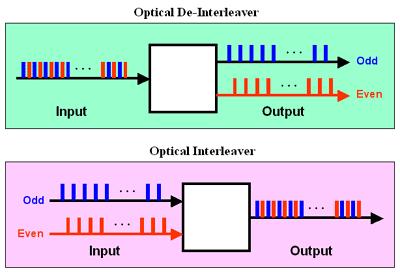
Optical interleaver
Encyclopedia

Interleaving
In computer science and telecommunication, interleaving is a way to arrange data in a non-contiguous way to increase performance.It is typically used:* In error-correction coding, particularly within data transmission, disk storage, and computer memory....
way. For example, optical interleaver takes two multiplexed signals with 100 GHz spacing and interleaves them, creating a denser DWDM signal with channels spaced 50 GHz apart. The process can be repeated, creating even denser composite signals with 25 GHz or 12.5 GHz spacing.
The device can be used in a reverse direction, forming an optical deinterleaver that separates a denser DWDM signal into odd channels and even channels. See schematic diagram.
For example, in most DWDM equipment, the standard channel spacing is 100 GHz. But spacing the signal-carrying frequencies every 50 or even 25 GHz can double or even quadruple the number of channels per fiber. Thus, optical interleaver can expand the number of channels per fiber, and devices and/or networks can be upgraded without requiring that all devices be upgraded.
Optical interleaver is based on multiple-beam interference. Currently, there are two approaches to building optical interleaver: 1) Step-phase Michelson interferometer
Michelson interferometer
The Michelson interferometer is the most common configuration for optical interferometry and was invented by Albert Abraham Michelson. An interference pattern is produced by splitting a beam of light into two paths, bouncing the beams back and recombining them...
, and 2) Birefringent
Birefringence
Birefringence, or double refraction, is the decomposition of a ray of light into two rays when it passes through certain anisotropic materials, such as crystals of calcite or boron nitride. The effect was first described by the Danish scientist Rasmus Bartholin in 1669, who saw it in calcite...
crystal
Crystal
A crystal or crystalline solid is a solid material whose constituent atoms, molecules, or ions are arranged in an orderly repeating pattern extending in all three spatial dimensions. The scientific study of crystals and crystal formation is known as crystallography...
networks. The former is based on Michelson interferometer combined with Gires-Tournois interferometer.


